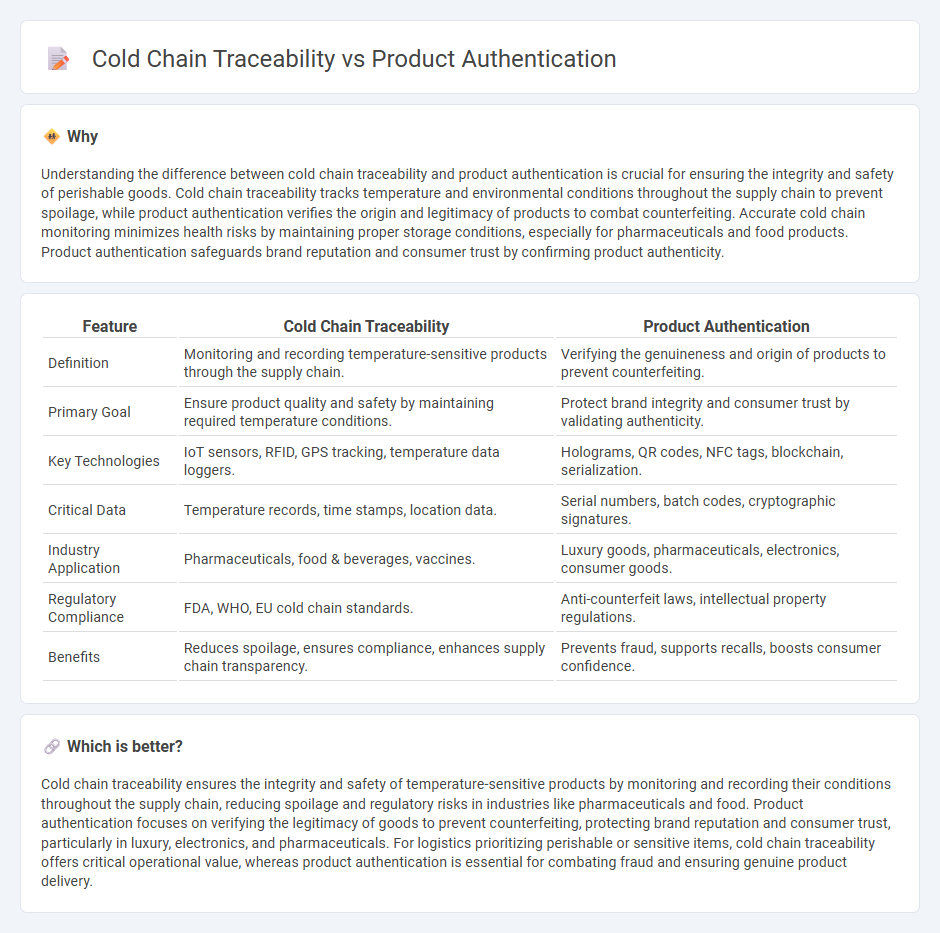
Cold chain traceability ensures temperature-sensitive products remain within required conditions throughout transportation, minimizing spoilage and compliance risks. Product authentication verifies the genuineness of goods, protecting against counterfeits and ensuring consumer safety. Discover how integrating both enhances supply chain integrity and customer trust.
Why it is important
Understanding the difference between cold chain traceability and product authentication is crucial for ensuring the integrity and safety of perishable goods. Cold chain traceability tracks temperature and environmental conditions throughout the supply chain to prevent spoilage, while product authentication verifies the origin and legitimacy of products to combat counterfeiting. Accurate cold chain monitoring minimizes health risks by maintaining proper storage conditions, especially for pharmaceuticals and food products. Product authentication safeguards brand reputation and consumer trust by confirming product authenticity.
Comparison Table
| Feature | Cold Chain Traceability | Product Authentication |
|---|---|---|
| Definition | Monitoring and recording temperature-sensitive products through the supply chain. | Verifying the genuineness and origin of products to prevent counterfeiting. |
| Primary Goal | Ensure product quality and safety by maintaining required temperature conditions. | Protect brand integrity and consumer trust by validating authenticity. |
| Key Technologies | IoT sensors, RFID, GPS tracking, temperature data loggers. | Holograms, QR codes, NFC tags, blockchain, serialization. |
| Critical Data | Temperature records, time stamps, location data. | Serial numbers, batch codes, cryptographic signatures. |
| Industry Application | Pharmaceuticals, food & beverages, vaccines. | Luxury goods, pharmaceuticals, electronics, consumer goods. |
| Regulatory Compliance | FDA, WHO, EU cold chain standards. | Anti-counterfeit laws, intellectual property regulations. |
| Benefits | Reduces spoilage, ensures compliance, enhances supply chain transparency. | Prevents fraud, supports recalls, boosts consumer confidence. |
Which is better?
Cold chain traceability ensures the integrity and safety of temperature-sensitive products by monitoring and recording their conditions throughout the supply chain, reducing spoilage and regulatory risks in industries like pharmaceuticals and food. Product authentication focuses on verifying the legitimacy of goods to prevent counterfeiting, protecting brand reputation and consumer trust, particularly in luxury, electronics, and pharmaceuticals. For logistics prioritizing perishable or sensitive items, cold chain traceability offers critical operational value, whereas product authentication is essential for combating fraud and ensuring genuine product delivery.
Connection
Cold chain traceability ensures the continuous monitoring of temperature-sensitive products during storage and transportation, which is crucial for maintaining product integrity. Product authentication relies on reliable traceability data to verify the origin, handling conditions, and legitimacy of goods within the cold chain. Integrating cold chain traceability with authentication systems enhances supply chain transparency and prevents counterfeit or compromised products from reaching consumers.
Key Terms
Serialization
Serialization enhances product authentication by assigning unique identifiers to each item, enabling precise verification of origin and preventing counterfeiting. In cold chain traceability, serialization tracks temperature-sensitive products through every stage, ensuring integrity and compliance with safety standards. Discover how serialization revolutionizes both authentication and cold chain logistics for optimal supply chain security.
Temperature monitoring
Temperature monitoring plays a crucial role in product authentication by ensuring that goods remain within specified thermal conditions, preventing tampering or spoilage during transit. Cold chain traceability leverages real-time temperature data to maintain quality and safety for perishable items, enabling detailed tracking from origin to destination. Explore advanced temperature monitoring solutions to enhance both product authentication and cold chain traceability effectiveness.
Chain of custody
Product authentication ensures the genuineness of goods through unique identifiers, while cold chain traceability monitors temperature-sensitive products to maintain quality during transit. Chain of custody provides a verifiable record of product handling, critical for both preventing counterfeits and ensuring compliance in cold chain logistics. Explore the integration of chain of custody in supply chain management to enhance security and transparency.
Source and External Links
Product authentication: Enhancing brand integrity - Digital Link - Product authentication verifies that a product is genuine to protect brand integrity and consumers, with solutions like digital link QR codes offering versatile, cost-effective methods for authentication, traceability, and consumer engagement integrated seamlessly into existing systems.
8 ways brands are using product authentication to boost their business - Product authentication not only reassures consumers but also helps brands combat counterfeiting, recover lost sales, track product distribution, and gain valuable market insights through secure digital IDs and data collected from consumer engagement.
DigiTrax(tm) Brand Protection Technology - Authentix - DigiTrax(tm) employs unique physical product tags that allow authentication and journey tracking via smartphones, providing real-time product origin, location data, and consumer engagement tools for comprehensive brand protection and supply chain management.
 dowidth.com
dowidth.com